Supermicro X11SSW-4TF User manual
- Category
- Server/workstation motherboards
- Type
- User manual
This manual is also suitable for

USER MANUAL
Revision 1.0a
X11SSW-TF
X11SSW-4TF

The information in this user’s manual has been carefully reviewed and is believed to be accurate. The vendor assumes
no responsibility for any inaccuracies that may be contained in this document, and makes no commitment to update
or to keep current the information in this manual, or to notify any person or organization of the updates. Please Note:
For the most up-to-date version of this manual, please see our website at www.supermicro.com.
Super Micro Computer, Inc. ("Supermicro") reserves the right to make changes to the product described in this manual
at any time and without notice. This product, including software and documentation, is the property of Supermicro and/
or its licensors, and is supplied only under a license. Any use or reproduction of this product is not allowed, except
as expressly permitted by the terms of said license.
IN NO EVENT WILL Super Micro Computer, Inc. BE LIABLE FOR DIRECT, INDIRECT, SPECIAL, INCIDENTAL,
SPECULATIVE OR CONSEQUENTIAL DAMAGES ARISING FROM THE USE OR INABILITY TO USE THIS PRODUCT
OR DOCUMENTATION, EVEN IF ADVISED OF THE POSSIBILITY OF SUCH DAMAGES. IN PARTICULAR, SUPER
MICRO COMPUTER, INC. SHALL NOT HAVE LIABILITY FOR ANY HARDWARE, SOFTWARE, OR DATA STORED
OR USED WITH THE PRODUCT, INCLUDING THE COSTS OF REPAIRING, REPLACING, INTEGRATING,
INSTALLING OR RECOVERING SUCH HARDWARE, SOFTWARE, OR DATA.
Any disputes arising between manufacturer and customer shall be governed by the laws of Santa Clara County in the
State of California, USA. The State of California, County of Santa Clara shall be the exclusive venue for the resolution
of any such disputes. Supermicro's total liability for all claims will not exceed the price paid for the hardware product.
FCC Statement: This equipment has been tested and found to comply with the limits for a Class A digital device
pursuant to Part 15 of the FCC Rules. These limits are designed to provide reasonable protection against harmful
interference when the equipment is operated in a commercial environment. This equipment generates, uses, and can
radiate radio frequency energy and, if not installed and used in accordance with the manufacturer’s instruction manual,
may cause harmful interference with radio communications. Operation of this equipment in a residential area is likely
to cause harmful interference, in which case you will be required to correct the interference at your own expense.
California Best Management Practices Regulations for Perchlorate Materials: This Perchlorate warning applies only
to products containing CR (Manganese Dioxide) Lithium coin cells. “Perchlorate Material-special handling may apply.
See www.dtsc.ca.gov/hazardouswaste/perchlorate”.
WARNING: Handling of lead solder materials used in this product may expose you to lead, a
chemical known to the State of California to cause birth defects and other reproductive harm.
The products sold by Supermicro are not intended for and will not be used in life support systems, medical equipment,
nuclear facilities or systems, aircraft, aircraft devices, aircraft/emergency communication devices or other critical
systems whose failure to perform be reasonably expected to result in signicant injury or loss of life or catastrophic
property damage. Accordingly, Supermicro disclaims any and all liability, and should buyer use or sell such products
for use in such ultra-hazardous applications, it does so entirely at its own risk. Furthermore, buyer agrees to fully
indemnify, defend and hold Supermicro harmless for and against any and all claims, demands, actions, litigation, and
proceedings of any kind arising out of or related to such ultra-hazardous use or sale.
Manual Revision: 1.0a
Release Date: August 10, 2017
Unless you request and receive written permission from Super Micro Computer, Inc., you may not copy any part of this
document. Information in this document is subject to change without notice. Other products and companies referred
to herein are trademarks or registered trademarks of their respective companies or mark holders.
Copyright © 2017 by Super Micro Computer, Inc.
All rights reserved.
Printed in the United States of America

3
Preface
Preface
About This Manual
This manual is written for system integrators, IT technicians and knowledgeable end users.
It provides information for the installation and use of the X11SSW-TF/-4TF motherboard.
About This Motherboard
The Super X11SSW-TF/-4TF motherboard supports Intel® Xeon® E3-1200 v6/v5 series,
7th/6th Gen Core™ i3, Pentium®, and Celeron® processors in an LGA 1151 (H4) socket.
With support of the Intel C236 chipset, DDR4 2400MHz memory, SATA 3.0 connectors,
PCIe 3.0 slot, M.2 slot, two (-TF) or four (-4TF) 10GbE Base-T and Trusted Platform Module
(TPM), this motherboard offers a cost-effective WIO server solution, and is ideal for 1U/2
AOC applications. Please note that this motherboard is intended to be installed and serviced
by professional technicians only. For processor/memory updates, please refer to our website
at http://www.supermicro.com/products/.
Conventions Used in the Manual
Special attention should be given to the following symbols for proper installation and to prevent
damage done to the components or injury to yourself:
Warning! Indicates high voltage may be encountered when performing a procedure.
Warning! Indicates important information given to prevent equipment/property damage
or personal injury.
Important: Important information given to ensure proper system installation or to
relay safety precautions.
Note: Additional Information given to differentiate various models or to provide in-
formation for correct system setup.

4
Contacting Supermicro
Headquarters
Address: Super Micro Computer, Inc.
980 Rock Ave.
San Jose, CA 95131 U.S.A.
Tel: +1 (408) 503-8000
Fax: +1 (408) 503-8008
Email: [email protected] (General Information)
[email protected] (Technical Support)
Website: www.supermicro.com
Europe
Address: Super Micro Computer B.V.
Het Sterrenbeeld 28, 5215 ML
's-Hertogenbosch, The Netherlands
Tel: +31 (0) 73-6400390
Fax: +31 (0) 73-6416525
Email: [email protected] (General Information)
[email protected] (Technical Support)
[email protected] (Customer Support)
Website: www.supermicro.nl
Asia-Pacic
Address: Super Micro Computer, Inc.
3F, No. 150, Jian 1st Rd.
Zhonghe Dist., New Taipei City 235
Taiwan (R.O.C)
Tel: +886-(2) 8226-3990
Fax: +886-(2) 8226-3992
Email: [email protected]
Website: www.supermicro.com.tw
X11SSW-TF/-4TF User Manual

5
Table of Contents
Chapter 1 Introduction
1.1 Checklist ...............................................................................................................................8
Quick Reference ...............................................................................................................12
Quick Reference Table ......................................................................................................13
Motherboard Features .......................................................................................................15
1.2 Processor and Chipset Overview .......................................................................................19
1.3 Special Features ................................................................................................................19
Recovery from AC Power Loss .........................................................................................19
1.4 System Health Monitoring ..................................................................................................20
Onboard Voltage Monitors ................................................................................................20
Fan Status Monitor with Firmware Control .......................................................................20
Environmental Temperature Control .................................................................................20
System Resource Alert......................................................................................................20
1.5 ACPI Features ....................................................................................................................20
1.6 Power Supply .....................................................................................................................21
1.7 Serial Port ...........................................................................................................................21
Chapter 2 Installation
2.1 Static-Sensitive Devices .....................................................................................................22
Precautions .......................................................................................................................22
Unpacking .........................................................................................................................22
2.2 Motherboard Installation .....................................................................................................23
Tools Needed ....................................................................................................................23
Location of Mounting Holes ..............................................................................................23
Installing the Motherboard.................................................................................................24
2.3 Processor and Heatsink Installation ...................................................................................25
Installing the LGA1151 Processor .....................................................................................25
Installing an Active CPU Heatsink with Fan .....................................................................28
Removing the Heatsink .....................................................................................................30
2.4 Memory Support and Installation .......................................................................................31
Memory Support ................................................................................................................31
DIMM Module Population Conguration ...........................................................................31
Preface

6
DIMM Module Population Sequence ................................................................................32
DIMM Installation ..............................................................................................................33
DIMM Removal .................................................................................................................33
2.5 Rear I/O Ports ....................................................................................................................34
2.6 Front Control Panel ............................................................................................................39
2.7 Connectors .........................................................................................................................44
Power Connections ...........................................................................................................44
Headers .............................................................................................................................46
2.8 Jumper Settings .................................................................................................................57
How Jumpers Work ...........................................................................................................57
2.9 LED Indicators ....................................................................................................................63
Chapter 3 Troubleshooting
3.1 Troubleshooting Procedures ..............................................................................................66
Before Power On ..............................................................................................................66
No Power ..........................................................................................................................66
No Video ...........................................................................................................................66
System Boot Failure ..........................................................................................................67
Memory Errors ..................................................................................................................67
Losing the System's Setup Conguration .........................................................................68
When the System Becomes Unstable ..............................................................................68
3.2 Technical Support Procedures ...........................................................................................70
3.3 Frequently Asked Questions ..............................................................................................71
3.4 Battery Removal and Installation .......................................................................................72
Battery Removal ................................................................................................................72
Proper Battery Disposal ....................................................................................................72
Battery Installation .............................................................................................................72
3.5 Returning Merchandise for Service ....................................................................................73
Chapter 4 BIOS
4.1 Introduction .........................................................................................................................74
Starting the Setup Utility ...................................................................................................74
4.2 Main Setup .........................................................................................................................75
4.3 Advanced Setup Congurations .........................................................................................77
4.4 Event Logs .......................................................................................................................100
X11SSW-TF/-4TF User Manual

7
Preface
4.5 IPMI ..................................................................................................................................102
4.6 Security .............................................................................................................................105
4.7 Boot ..................................................................................................................................108
4.8 Save & Exit ....................................................................................................................... 110
Appendix A BIOS Codes
Appendix B Software Installation
B.1 Installing Software Programs ...........................................................................................113
Appendix C Standardized Warning Statements
Battery Handling .............................................................................................................. 115
Product Disposal .............................................................................................................117
Appendix D UEFI BIOS Recovery
Appendix E Dual Boot Block
BIOS Boot Block .............................................................................................................122
BIOS Boot Block Corruption Occurrence ......................................................................122

8
X11SSW-TF/-4TF User Manual
Main Parts List
Description Part Number Quantity
Supermicro Motherboard X11SSW-TF/-4TF 1
SATA Cables CBL-0044L 6
Quick Reference Guide MNL-1925-QRG 1
Chapter 1
Introduction
Congratulations on purchasing your computer motherboard from an industry leader. Supermicro
boards are designed to provide you with the highest standards in quality and performance.
Several important parts that are included with the motherboard are listed below. If anything
listed is damaged or missing, please contact your retailer.
1.1 Checklist
Important Links
For your system to work properly, please follow the links below to download all necessary
drivers/utilities and the user’s manual for your server.
• Supermicro product manuals: http://www.supermicro.com/support/manuals/
• Product drivers and utilities: ftp://ftp.supermicro.com
• Product safety info: http://www.supermicro.com/about/policies/safety_information.cfm
• If you have any questions, please contact our support team at: [email protected]m
This manual may be periodically updated without notice. Please check the Supermicro website
for possible updates to the manual revision level.

9
Chapter 1: Introduction
Figure 1-1. X11SSW-TF Motherboard Image

10
X11SSW-TF/-4TF User Manual
Figure 1-2. X11SSW-4TF Motherboard Image
Note: All graphics shown in this manual were based upon the latest PCB revision
available at the time of publication of the manual. The motherboard you received may
or may not look exactly the same as the graphics shown in this manual.

11
Chapter 1: Introduction
Figure 1-3. X11SSW-TF/-4TF Motherboard Layout
(not drawn to scale)
Note: Components not documented are for internal testing only.
SAN MAC
+
IPMI CODE
BIOS
LICENSE
BAR CODE
MAC CODE
DESIGNED IN USA
X11SSW-TF
REV:1.01
JPW2
JSTBY1
JSD2 JSD1
JIPMB1
I-SGPIO1
I-SGPIO2
JSXB1C
JSXB1A
JSXB1B
JD1
JBAT1
SP1
JF2
JF1
JUIDB1
LED1
LED3
JL1
JPW1
JPI2C1
I-SATA5
I-SATA0
I-SATA1
I-SATA4
I-SATA3
I-SATA2
JTPM1
JBR1
JWD1
JLED1
JPME2
JPL2
JPL1
JI2C2
JI2C1
JPB1
JPG1
JBT1
DIMMA1
DIMMA2
DIMMB1
DIMMB2
BMC
PCH
JNVME1
LED2
FAN6
FAN5
VGA
FAN4 FAN3
LAN1/2
USB6/7
(3.0)
USB0/1
IPMI_LAN
COM1
FAN2
FAN1
USB9/10(3.0)
USB8(3.0)
USB4/5
USB2/3
COM2
CPU
LAN3/4
LAN1/2
CTRL
LAN3/4
CTRL
J3
Differences between X11SSW-TF and X11SSW-4TF
X11SSW-TF X11SSW-4TF
LAN3/LAN4 No Yes

12
X11SSW-TF/-4TF User Manual
Notes:
• See Chapter 2 for detailed information on jumpers, I/O ports, and JF1 front panel con-
nections.
• " " indicates the location of Pin 1.
• Jumpers/LED indicators not indicated are used for testing only.
• When JLED1 (Onboard Power LED indicator) is on, system power is on. Unplug the power
cable before installing or removing any components.
Quick Reference
SAN MAC
+
IPMI CODE
BIOS
LICENSE
BAR CODE
MAC CODE
DESIGNED IN USA
X11SSW-TF
REV:1.01
JPW2
JSTBY1
JSD2 JSD1
JIPMB1
I-SGPIO1
I-SGPIO2
JSXB1C
JSXB1A
JSXB1B
JD1
JBAT1
SP1
JF2
JF1
JUIDB1
LED1
LED3
JL1
JPW1
JPI2C1
I-SATA5
I-SATA0
I-SATA1
I-SATA4
I-SATA3
I-SATA2
JTPM1
JBR1
JWD1
JLED1
JPME2
JPL2
JPL1
JI2C2
JI2C1
JPB1
JPG1
JBT1
DIMMA1
DIMMA2
DIMMB1
DIMMB2
BMC
PCH
JNVME1
LED2
FAN6
FAN5
VGA
FAN4 FAN3
LAN1/2
USB6/7
(3.0)
USB0/1
IPMI_LAN
COM1
FAN2
FAN1
USB9/10(3.0)
USB8(3.0)
USB4/5
USB2/3
COM2
CPU
LAN3/4
LAN1/2
CTRL
LAN3/4
CTRL
J3
VGA
LAN3/4
LAN1/2
USB8
USB0/1
COM1
IPMI_LAN
JUIDB1 LED1
COM2
SP1
USB4/5
USB9/10
JIPMB1
USB6/7
JTPM1
JPI2C1
FAN1
FAN2
FAN3FAN4
JF1
I-SGPIO1
I-SGPIO2
I-SATA3
I-SATA2
JSD1
JSD2
JSXB1C
JSXB1B
JSXB1A
I-SATA4
I-SATA5
DIMMA1
DIMMA2
DIMMB1
DIMMB2
JBT1
JBAT1
JPL1
JPB1
JI2C1
JI2C2
JPG1
JPL2
FAN5FAN6
JPW2
JD1
USB2/3
JPW1
JL1
JF2
JSTBY1
I-SATA1
I-SATA0
LED3
LED2
JBR1
JWD1
JPME2
J3
JNVME1
JLED1

13
Chapter 1: Introduction
Note: Table is continued on the next page.
Quick Reference Table
Jumper Description Default Setting
JBR1 BIOS Recovery Pins 1-2 (Normal)
JBT1 Clear CMOS Short: Clear CMOS, Open: Normal
JI2C1/JI2C2 SMB to PCI Slots Pins 1-2 (Enabled)
JNVME1 NVMe Enable Pins 2-3 (Auto)
JPB1 BMC Enable/Disable Pins 1-2 (Enabled)
JPG1 VGA Enable Pins 1-2 (Enabled)
JPL1 LAN1/LAN2 Enable Pins 1-2 (Enabled)
JPL2 LAN3/LAN4 Enable Pins 1-2 (Enabled)
JPME2 Manufacturing Mode Select Pins 1-2 (Normal)
JWD1 Watch Dog Enable Pins 1-2 (Reset)
LED Description Status
LED1 Rear UID LED Blue On: Unit Identied
LED2 Power LED Solid Green: Power On
LED3 Standby Power LED Solid Green: Standby Power On
Connector Description
COM1/COM2 COM1: Port, COM2: Header
FAN1 ~ FAN6 System/CPU Fan Headers
IPMI_LAN Dedicated IPMI Gigabit (RJ45) Port
I-SATA0 ~ I-SATA5 SATA 3.0 Connectors via Intel PCH (6Gb/s)
I-SGPIO 1/2 Serial Link General Purpose I/O Connection Headers for I-SATA 3.0 connections
(I-SGPIO1 for I-SATA0~3, I-SGPIO2 for I-SATA4~5)
J3 M.2 Socket 3 (supports 2260, 2280, 22110 for NVMe)
JBAT1 Onboard Battery
JD1 Speaker/Buzzer Header (Pins 1-4: Speaker, Pins 3-4: Buzzer)
JF1 Front Control Panel Header
JF2 Activity LED Header for LAN3/LAN4
JIPMB1 4-pin External BMC I
2
C Header (for an IPMI Card)
JL1 Chassis Intrusion Header
JLED1 3-pin Power LED Indicator Header
JPI2C1 Power I2C System Management Bus (Power SMB) Header
JPW1 24-pin ATX Main Power Connector (Required)
JPW2 +12V 8-pin CPU Power Connector (Required)
JSD1/JSD2 SATA Disk On Module (DOM) Power Connectors
JSTBY1 Standby Power Header
JSXB1A/1B/1C SMC Proprietary WIO_L (Left) Add-On Card Slot

14
X11SSW-TF/-4TF User Manual
Connector Description
JTPM1 Trusted Platform Module (TPM)/Port 80 Connector
JUIDB1 UID (Unit Identication) Switch
LAN1/LAN2/LAN3/LAN4 10 Gigabit (RJ45) LAN Ports
SP1 Internal Speaker/Buzzer
USB 0/1 Back Panel USB 2.0 Ports
USB 2/3, USB 4/5 Front Accessible USB 2.0 Headers
USB 6/7 Back Panel USB 3.0 Ports
USB 8 Front Accessible USB 3.0 Type-A Header
USB 9/10 Front Accessible USB 3.0 Header
VGA Back Panel VGA Port

15
Chapter 1: Introduction
Note: The table above is continued on the next page.
Motherboard Features
CPU
• Intel® Xeon® E3-1200 v6/v5 series, 7th/6th Gen Core™ i3, Pentium®, and Celeron® processors in an LGA1151 (H4)
socket. 80W max TDP.
Memory
• Four (4) 288-pin DIMM slots support up to 64 GB of SDRAM 72-bit DDR4 unbuffered ECC 2400/2133/1866/1600MHz
memory.
DIMM Size
• 16GB, 8GB, and 4GB, up to 64GB at 1.2V
Note 1: Memory speed support depends on the processors used in the system.
Note 2: For the latest CPU/memory updates, please refer to our website at http://www.supermicro.com/products/
motherboard.
Chipset
• Intel PCH C236
Expansion Slots
• One (1) SMC-Proprietary WIO-L slots (JSXB1A/1B/1C)
• One (1) M.2 NGFF connector [supports PCIe 3.0 x4 (32 Gb/s)]
Network
• Two Intel® 10G LAN chips (X540-AT2) for LAN1/LAN2/LAN3/LAN4
Baseboard Management Controller (BMC)
• ASpeed AST 2400 Baseboard Managemenr Controller (BMC) supports IPMI 2.0
• One (1) Dedicated IPMI LAN located on the rear I/O back panel
Graphics
• Graphics controller via ASpeed 2400 BMC
I/O Devices
• Serial (COM) Port
• One (1) serial port on the rear I/O panel (COM1)
• One (1) front accessible serial header (COM2)
• SATA 3.0
• Six (6) I-SATA 3.0 ports (I-SATA0 ~ 5)
• Two (2) SuperDOM connectors (I-SATA4 & I-SATA5)
• RAID (PCH) • RAID 0, 1, 5, and 10
Motherboard Features

16
X11SSW-TF/-4TF User Manual
Note: The table above is continued on the next page.
Motherboard Features
Peripheral Devices
• Two (2) USB 2.0 ports on the rear I/O panel (USB 0/1)
• Two (2) front accessible USB 2.0 headers (USB 2/3, 4/5)
• Two (2) USB 3.0 ports on the rear I/O panel (USB 6/7)
• One (1) USB 3.0 Type-A header (USB 8)
• One (1) front accessible USB 3.0 header (USB 9/10)
BIOS
• 128Mb AMI BIOS® SPI Flash BIOS
• Plug and Play (PnP), Riser Card auto-detection, dual boot block, DMI 3.0, ACPI 3.0+, USB Keyboard, BIOS rescue hot-
key, and SMBIOS 2.7+
Power Management
• ACPI power management
• CPU fan auto-off in sleep mode
• Power button override mechanism
• Power-on mode for AC power recovery
System Health Monitoring
• Onboard voltage monitors for CPU cores, +3.3V, +5V, +12V, +5V AUX, +3.3V Stby, VBAT, VSA, Memory, PCH temperature,
and system temperature
• CPU 3+2-phase switching voltage regulator
• CPU/System overheat control
• CPU Thermal Trip support
Fan Control
• Fan status monitoring with rmware 4-pin fan speed control via IPMI interface
• Low noise fan speed control
System Management
• PECI (Platform Environment Conguration Interface) 3.1 support
• Intel® Node Manager
• IPMI 2.0 with KVM support
• SuperDoctor® 5, Watch Dog, NMI
• Chassis Intrusion header and detection
• Power supply monitoring
LED Indicators
• CPU/system overheat LED
• Power / suspend-state indicator LED
• Fan failed LED
• UID / Remote UID
• HDD activity LED
• LAN activity LED

17
Chapter 1: Introduction
Motherboard Features
Other
• RoHS
Dimensions
• WIO form factor (13.0" x 8.0") (330.20 mm x 203.20 mm)
Note 1: The CPU maximum thermal design power (TDP) is subject to chassis and
heatsink cooling restrictions. For proper thermal management, please check the chas-
sis and heatsink specications for proper CPU TDP sizing.
Note 2: For IPMI conguration instructions, please refer to the Embedded IPMI Con-
guration User's Guide available at http://www.supermicro.com/support/manuals/.

18
X11SSW-TF/-4TF User Manual
Note: This is a general block diagram and may not exactly represent the features on
your motherboard. See the previous pages for the actual specications of your moth-
erboard.
Figure 1-4.
Chipset Block Diagram
#A-1
#B-0
#B-1
PCI-E X4 GEN2 / 5.0Gb/S
#1~#4
#5~#8
LAN1
RJ45
MUX
SPI
X540-AT2
LAN 1/2
SPI
PHY
RGRMII
Debug Card
FRONT PANEL
SYSTEM POWER
CTRL
FAN SPEED
PCI-E X1 2.5 Gb/S
USB 2.0
#13 USB2.0
#0~#5
USB 3.0
USB
#1
#2
#3
#4
#5
PCH
6.0 Gb/S
USB 2.0
LPC
USB
#1
#0
SATA
#5
#4
RTL8211F-CG
#3
#2
RJ45
SPI
Temp Sensor
TPM HEADER
BIOS
SPI
AST2400
BMC
#9/10/11/12
#19
RMII/NCSI
COM1
Connector
COM2
Header
VGA CONN
BMC Boot Flash
DDR3
PCIe 3.0 x16SXB1
M.2 SSD
#1
#2
#3
#4
#5
#6
LAN2
RJ45
LAN3
RJ45
X540-AT2
LAN 3/4
LAN4
RJ45
PCI-E X4 GEN2 / 5.0Gb/S
#7
#8
#10
#11
#9
3 PHASE for Vcore
1 PHASE for VSA
IMVP 8 80W
DDR4-2400/2133
#A-0
DMI3
Skt-H4
LGA1151
#0-15
DMI3 x4
PCI-E X16 8.0 Gb/S
PCI-E X4 8.0 Gb/S

19
Chapter 1: Introduction
1.2 Processor and Chipset Overview
Built upon the functionality and capability of the Intel E3-1200 v6/v5 series processors (Socket
LGA 1151) and the Intel C236 PCH, the X11SSW-TF/-4TF motherboard offers maximum I/O
expandability, energy efciency, and data reliability in a 14-nm process architecture, and
is optimized for embedded storage solutions, networking applications, or cloud-computing
platforms.
The Intel E3-1200 v6/v5 and PCH C236 platform supports the following features:
• ACPI Power Management Logic Support, Rev. 4.0a
• Intel Turbo Boost Technology 2.0 Power Monitoring/Power Control, Turbo Time Parameter
(TAU), and Platform Power Control
• Congurable TDP (cTDP) and Lower-Power Mode
• Adaptive Thermal Management/Monitoring
• PCI-E 3.0, SATA 3.0 with transfer rates of up to 6 Gb/s, xHCI USB with SuperSpeed 3.0
• System Management Bus (SMBus) Specication, Version 2.0
• Integrated Sensor Hub (ISH)
• Intel Trusted Execution Technology (Intel TXT)
• Intel Rapid Storage Technology
• Intel Virtualization Technology for Directed I/O (Intel VT-d)
1.3 Special Features
This section describes the health monitoring features of the X11SSW-TF/-4TF motherboard.
The motherboard has an onboard System Hardware Monitor chip that supports system health
monitoring.
Recovery from AC Power Loss
The Basic I/O System (BIOS) provides a setting that determines how the system will respond
when AC power is lost and then restored to the system. You can choose for the system to
remain powered off (in which case you must press the power switch to turn it back on), or
for it to automatically return to the power-on state. See the Advanced BIOS Setup section
for this setting. The default setting is Last State.

20
X11SSW-TF/-4TF User Manual
1.4 System Health Monitoring
The motherboard has an onboard Baseboard Management Controller (BMC) chip that
supports system health monitoring.
Onboard Voltage Monitors
The onboard voltage monitor will continuously scan crucial voltage levels. Once a voltage
becomes unstable, it will give a warning or send an error message to the screen. Users can
adjust the voltage thresholds to dene the sensitivity of the voltage monitor. Real time readings
of these voltage levels are all displayed in BIOS.
Fan Status Monitor with Firmware Control
The system health monitor chip can check the RPM status of a cooling fan. The CPU and
chassis fans are controlled by BIOS Thermal Management through the back panel.
Environmental Temperature Control
System Health sensors monitor temperatures and voltage settings of onboard processors
and the system in real time via the IPMI interface. Whenever the temperature of the CPU or
the system exceeds a user-dened threshold, system/CPU cooling fans will be turned on to
prevent the CPU or the system from overheating
Note: To avoid possible system overheating, please be sure to provide adequate air-
ow to your system.
System Resource Alert
This feature is available when used with SuperDoctor 5® in the Windows OS or in the Linux
environment. SuperDoctor is used to notify the user of certain system events. For example,
you can congure SuperDoctor to provide you with warnings when the system temperature,
CPU temperatures, voltages and fan speeds go beyond a predened range.
1.5 ACPI Features
ACPI stands for Advanced Conguration and Power Interface. The ACPI specication denes
a exible and abstract hardware interface that provides a standard way to integrate power
management features throughout a computer system, including its hardware, operating
system and application software. This enables the system to automatically turn on and off
peripherals such as CD-ROMs, network cards, hard disk drives and printers.
Page is loading ...
Page is loading ...
Page is loading ...
Page is loading ...
Page is loading ...
Page is loading ...
Page is loading ...
Page is loading ...
Page is loading ...
Page is loading ...
Page is loading ...
Page is loading ...
Page is loading ...
Page is loading ...
Page is loading ...
Page is loading ...
Page is loading ...
Page is loading ...
Page is loading ...
Page is loading ...
Page is loading ...
Page is loading ...
Page is loading ...
Page is loading ...
Page is loading ...
Page is loading ...
Page is loading ...
Page is loading ...
Page is loading ...
Page is loading ...
Page is loading ...
Page is loading ...
Page is loading ...
Page is loading ...
Page is loading ...
Page is loading ...
Page is loading ...
Page is loading ...
Page is loading ...
Page is loading ...
Page is loading ...
Page is loading ...
Page is loading ...
Page is loading ...
Page is loading ...
Page is loading ...
Page is loading ...
Page is loading ...
Page is loading ...
Page is loading ...
Page is loading ...
Page is loading ...
Page is loading ...
Page is loading ...
Page is loading ...
Page is loading ...
Page is loading ...
Page is loading ...
Page is loading ...
Page is loading ...
Page is loading ...
Page is loading ...
Page is loading ...
Page is loading ...
Page is loading ...
Page is loading ...
Page is loading ...
Page is loading ...
Page is loading ...
Page is loading ...
Page is loading ...
Page is loading ...
Page is loading ...
Page is loading ...
Page is loading ...
Page is loading ...
Page is loading ...
Page is loading ...
Page is loading ...
Page is loading ...
Page is loading ...
Page is loading ...
Page is loading ...
Page is loading ...
Page is loading ...
Page is loading ...
Page is loading ...
Page is loading ...
Page is loading ...
Page is loading ...
Page is loading ...
Page is loading ...
Page is loading ...
Page is loading ...
Page is loading ...
Page is loading ...
Page is loading ...
Page is loading ...
Page is loading ...
Page is loading ...
Page is loading ...
Page is loading ...
Page is loading ...
-
 1
1
-
 2
2
-
 3
3
-
 4
4
-
 5
5
-
 6
6
-
 7
7
-
 8
8
-
 9
9
-
 10
10
-
 11
11
-
 12
12
-
 13
13
-
 14
14
-
 15
15
-
 16
16
-
 17
17
-
 18
18
-
 19
19
-
 20
20
-
 21
21
-
 22
22
-
 23
23
-
 24
24
-
 25
25
-
 26
26
-
 27
27
-
 28
28
-
 29
29
-
 30
30
-
 31
31
-
 32
32
-
 33
33
-
 34
34
-
 35
35
-
 36
36
-
 37
37
-
 38
38
-
 39
39
-
 40
40
-
 41
41
-
 42
42
-
 43
43
-
 44
44
-
 45
45
-
 46
46
-
 47
47
-
 48
48
-
 49
49
-
 50
50
-
 51
51
-
 52
52
-
 53
53
-
 54
54
-
 55
55
-
 56
56
-
 57
57
-
 58
58
-
 59
59
-
 60
60
-
 61
61
-
 62
62
-
 63
63
-
 64
64
-
 65
65
-
 66
66
-
 67
67
-
 68
68
-
 69
69
-
 70
70
-
 71
71
-
 72
72
-
 73
73
-
 74
74
-
 75
75
-
 76
76
-
 77
77
-
 78
78
-
 79
79
-
 80
80
-
 81
81
-
 82
82
-
 83
83
-
 84
84
-
 85
85
-
 86
86
-
 87
87
-
 88
88
-
 89
89
-
 90
90
-
 91
91
-
 92
92
-
 93
93
-
 94
94
-
 95
95
-
 96
96
-
 97
97
-
 98
98
-
 99
99
-
 100
100
-
 101
101
-
 102
102
-
 103
103
-
 104
104
-
 105
105
-
 106
106
-
 107
107
-
 108
108
-
 109
109
-
 110
110
-
 111
111
-
 112
112
-
 113
113
-
 114
114
-
 115
115
-
 116
116
-
 117
117
-
 118
118
-
 119
119
-
 120
120
-
 121
121
-
 122
122
-
 123
123
Supermicro X11SSW-4TF User manual
- Category
- Server/workstation motherboards
- Type
- User manual
- This manual is also suitable for
Ask a question and I''ll find the answer in the document
Finding information in a document is now easier with AI
Related papers
-
Supermicro C7C242-CB-M User manual
-
Supermicro 5038AD-I User manual
-
Supermicro C7Z270-CG User manual
-
Supermicro C7Z170-OCE User manual
-
Supermicro AS-2113S-WN24RT User manual
-
Supermicro A1SAM Series Quick Reference Manual
-
Supermicro X10SL7-F User manual
-
Supermicro C7Z170-OCE User manual
-
Supermicro X11SSE-F User manual
-
Supermicro X10SLD-F User manual
Other documents
-
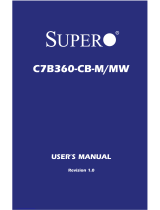 Supero C7B360-CB-M User manual
Supero C7B360-CB-M User manual
-
Gigabyte MW31-SP0 Owner's manual
-
SUPER MICRO Computer X10SLQ User manual
-
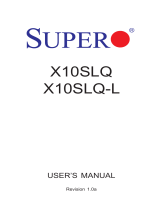 Supero X10SLQ User manual
Supero X10SLQ User manual
-
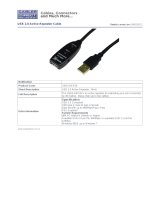 Cables Direct USB2-REP30 Datasheet
Cables Direct USB2-REP30 Datasheet
-
Thermaltake A2349 Datasheet
-
Digitus DA-70300-1 Datasheet
-
Shenzhen B W Electronics Development BT022 Wireless Mini Numeric Keypad User manual
-
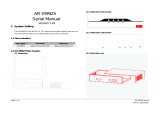 Acrosser Technology AR-M9925 Quick Manual
Acrosser Technology AR-M9925 Quick Manual
-
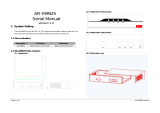 Acrosser Technology AR-M9925 Quick Manual
Acrosser Technology AR-M9925 Quick Manual































































































































